Perhaps the number one question about Baybayin is “How do I write my name in Baybayin?” The easiest way of course is to post this question in a Baybayin group and wait for someone to answer with a Baybayin transliteration of your name. However, if you are like me who loves to exercise their brain and learn new things, then you have come to the right place.
Because for today we will learn how to write our name in Baybayin!
But first, if you do not know how to read and write Baybayin, I made a post to help you do so. Please check How To Read and Write Baybayin.
Alright, let’s begin! There is a de facto rule within the Baybayin community that any foreign words should be translated first into Filipino before writing it in Baybayin. This rule extends to writing names as well (name equivalent). However, it is just more of a guide rather than being an official rule. Even other writing systems like Japan’s Kana or Korea’s Hangul transliterate foreign words and names without the need to translate or change them to their local equivalent.
And as for your name, whether you wish to change it first or to just transliterate it right away is all up to you. For example, if your name is Richard, you do have the option to render/translate it into Ricardo first or to transliterate it into Baybayin right away, like Ritsard or Rityard. After all, it is your name and no one knows how to write it best except you. As for me, I would highly recommend doing the latter. Just spell it the way you say it, no need to change it.
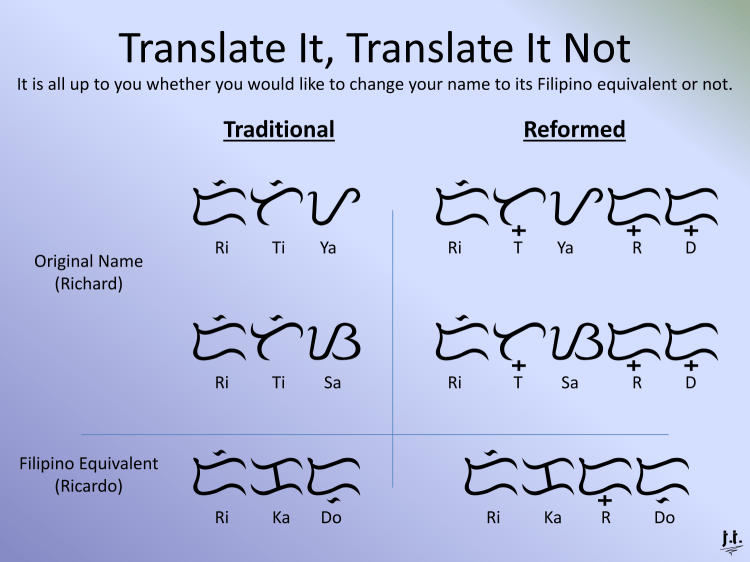
Please note, however, that what I am going to share here are just guidelines to help you write your name in Baybayin. In the end, it is still up to you how you are going to write your name. As long as it is legible then you are good to go. Names are of personal matter, but the last thing that you would want is to write your name in Baybayin the wrong way.
The Rule
In my previous post, I mentioned the rule of thumb in Baybayin. Don’t worry if you haven’t read it yet, the rule of Baybayin is simple:
“Kung ano ang bigkas, siyang baybay.” (Spell it the way you say it.)
Baybayin
And that is how it should be when writing your name as well. I also mentioned that we have two ways of writing Baybayin: Traditional and Reformed. We will cover both ways to write your name here in this post.
Spell It The Way You Say It
Yes, this is like the golden rule in Baybayin. Whether you have a foreign name with complicated spellings and lot of silent letters, it still boils down to this one rule. For example: if your name is Mae or May, then we should spell it as ᜋᜒ “Me” (traditional) or ᜋᜒᜌ᜔ “Mey” (reformed) and NOT ᜋᜁ (Ma-E) NOR ᜋᜆ᜔ (Ma-Y, pronounced as English “My” and not the month May). Always remember that the vowel characters in Baybayin are pronounced individually.
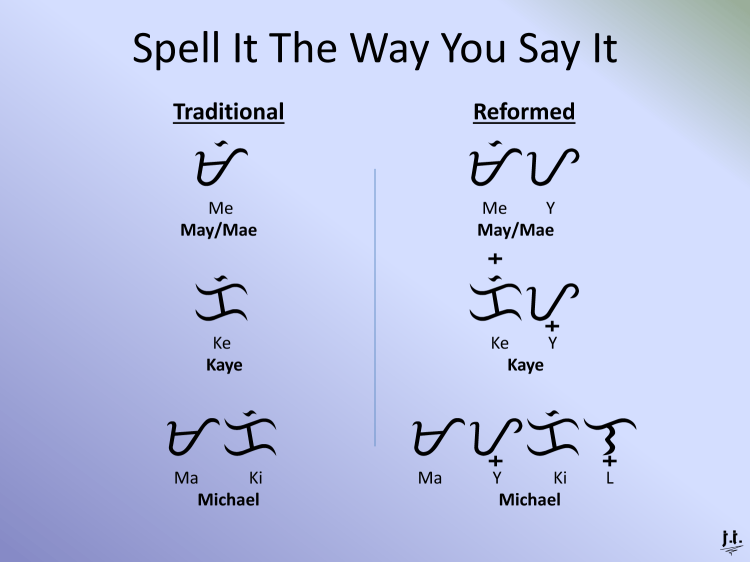
Baybayin Is NOT An Alphabet
One common mistake in writing names in Baybayin is by treating the characters like letters in the alphabet. For example, Pedro is mistakenly spelled as ᜉᜁᜇᜇᜂ. What was written was really not Pedro but actually Paedarao (Pa-E-Da-Ra-O). The correct way to spell the name is ᜉᜇᜓ (Pero) in traditional and ᜉᜒᜇ᜔ᜇᜓ (Pedro) in the reformed way. Remember that Baybayin is an Abugida or alphasyllabary. Also remember that final consonants are dropped in the traditional way.
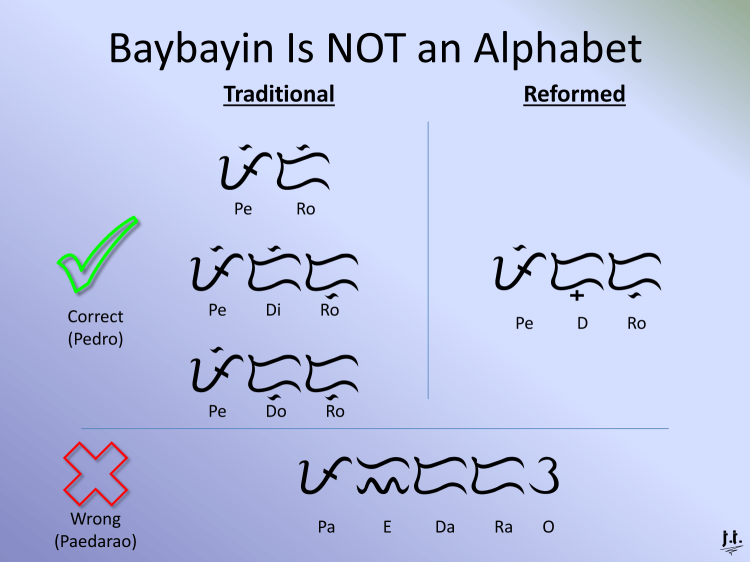
Initial Consonant Cluster
As mentioned in the previous post, in traditional writing, simply separate the consonants and insert a vowel for syllables that start with a consonant cluster. And simply use the virama in the reformed way. For example, if your name is Christian, then we should spell it as ᜃᜒᜇᜒᜆᜒᜌ “Kiritiya” (traditional) and ᜃ᜔ᜇᜒᜐ᜔ᜆ᜔ᜌᜈ᜔ “Kristyan” (reformed).
Furthermore, in our Pedro example earlier, the “D” can act as the final consonant in the syllable “Ped” rather than an initial consonant cluster in the final syllable “Dro”. That’s why the “D” was dropped in the traditional writing (Pero). However, it is still up to Pedro if he would like to spell his name as Pedoro/Pediro, or Pero in the traditional way of writing.
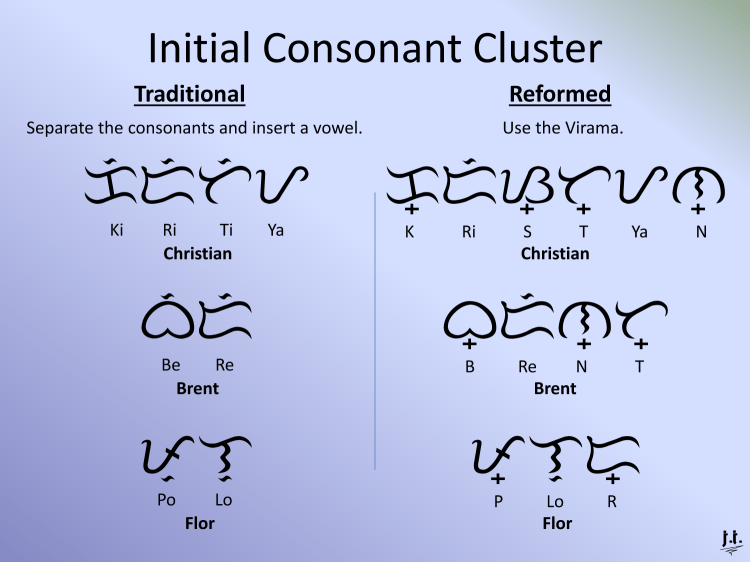
Diphthongs
Some of our examples earlier (Mae, May and Christian) also have diphthongs in them. For names with diphthongs, just remember not to use two consecutive vowel characters in Baybayin as they are pronounced individually. Another example is Paul. Paul should be spelled as ᜉᜓ “Po” (traditional) or ᜉᜓᜎ᜔ “Pol” in (reformed) and NOT Pa-UL (Pa-All).
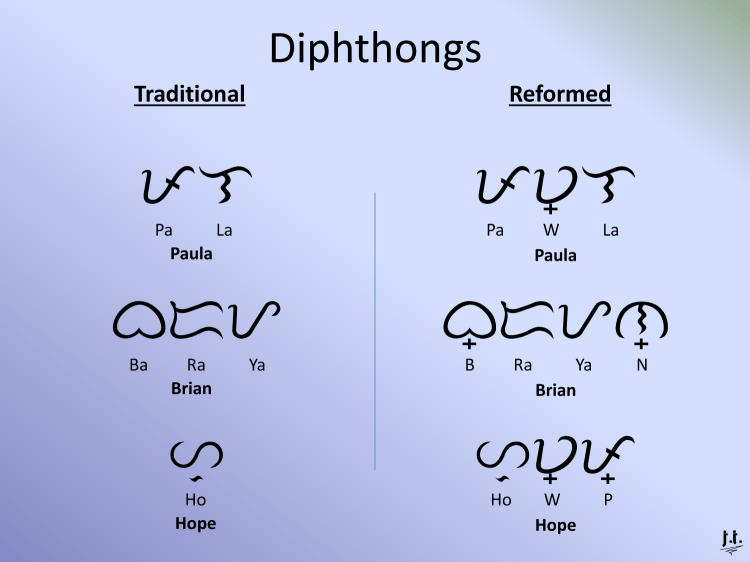
Silent Letters, Hyphen and Abbreviations
Silent letters if there are any are dropped since…err…well, they are silent and not pronounced at all. 😅
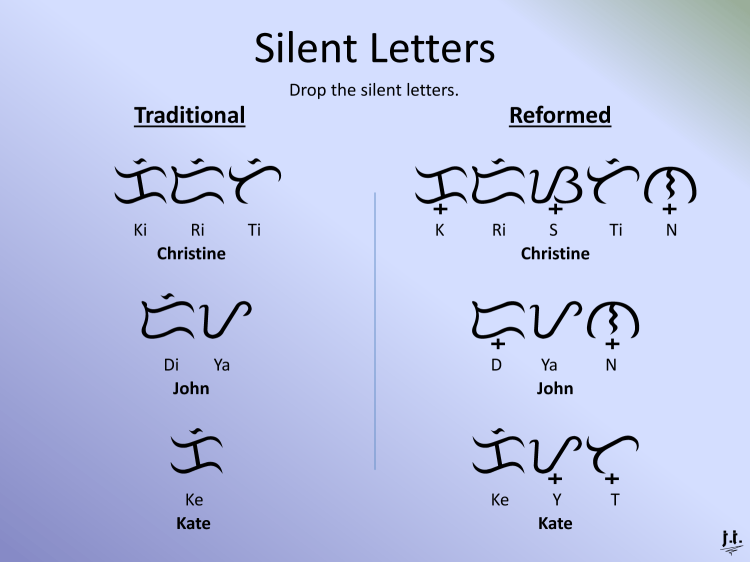
Hyphens are dropped as well and abbreviated names (with a full stop/period) should be spelled fully depending on the pronunciation, eg., Ma. as ᜋᜇᜒᜌ (Mariya “Maria”). However, if Ma. is pronounced as “Ma” instead of “Maria”, then writing it as “Ma” should be fine.

Foreign Sounds Guide
Foreign sounds or letters like C, Ch, F, J, Ll, Ñ, Q, Sh, V, X and Z can be written by compounding characters or via allophones. Just remember the rule to spell it the way you say it. I posted this before so I am just going to paste it here:
- C (like in cake) – Use “Ka” characters.
- C (like in center) – Use “Sa” characters.
- Ch (like in chance) – Use a combination of “Ti” (Traditional)/“T” (Reformed) and a “Ya” or “Sa” character.
- F – Use “Pa” characters.
- J (like in Juan) – Use “Ha” characters.
- J (like in John) – Use a combination of “Di” (Traditional)/“D” (Reformed) and a “Ya” character.
- Ll – Depending on the pronunciation, use either “Ya” or compounded “Ja” characters.
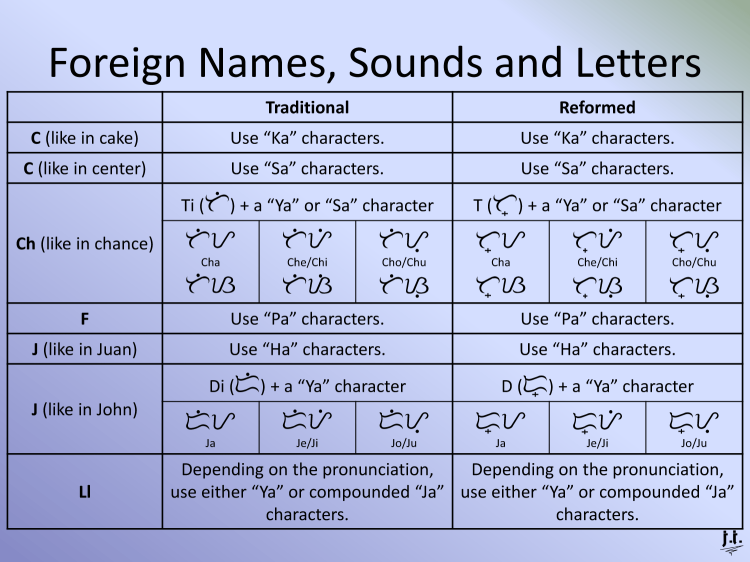
- Ll (like in Llamaz) – Use a combination of “Li” (Traditional)/“L” (Reformed) and a “Ya” character.
- Ñ – Use a combination of “Ni” (Traditional)/“N” (Reformed) and a “Ya” character.
- Q (like in Qatar) – Use “Ka” characters.
- Q (like in Queen) – Use a combination of “Ku” (Traditional)/“K” (Reformed) and a “Wa” character.
- Sh (like in ship) – Use a combination of “Si” (Traditional)/“S” (Reformed) and a “Ya” character.

- Th – Depending on the pronunciation, use either “Ta” or “Da” characters.
- V – Use “Ba” characters.
- X (like the ‘xe’ in xerox) – Use “Sa” characters.
- X (like in Roxas) – Use “Ha” characters.
- X (like in boxing) – Use a combination of “Ki” (Traditional)/“K” (Reformed) and a “Sa” character.
- X (like in exact) – Use a combination of “Gi” (Traditional)/“G” (Reformed) and a “Sa” characters.
- Z – Use “Sa” characters.
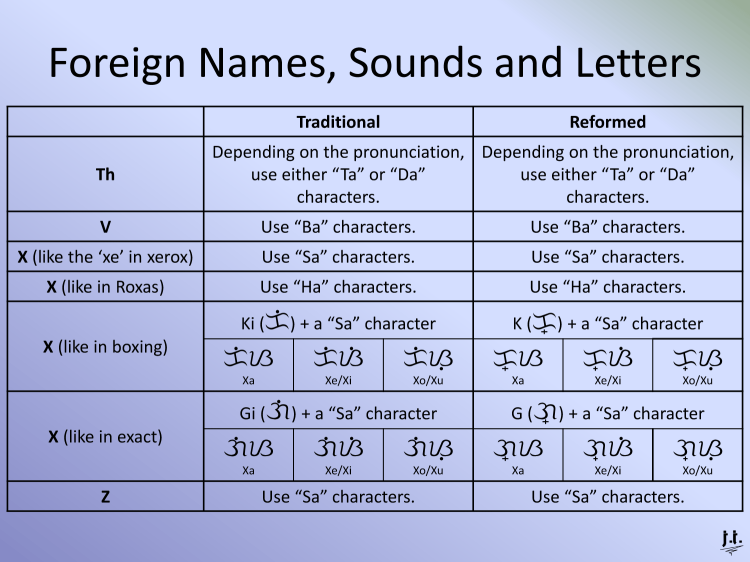
Suggested Modern Characters
A lot of suggestions were made to modernize the Baybayin. These suggestions added characters to accommodate foreign names and letters. I have explained this in another post at Versions of Baybayin.
We also have a modern Baybayin called Modern Baybayin B17+ (MB17+). This preserves the original 17 characters and instead of adding new characters, diacritics are added to accommodate foreign names and letters making it practical and easy to use and memorize. You can read more about it at Modern Baybayin (MB17+).
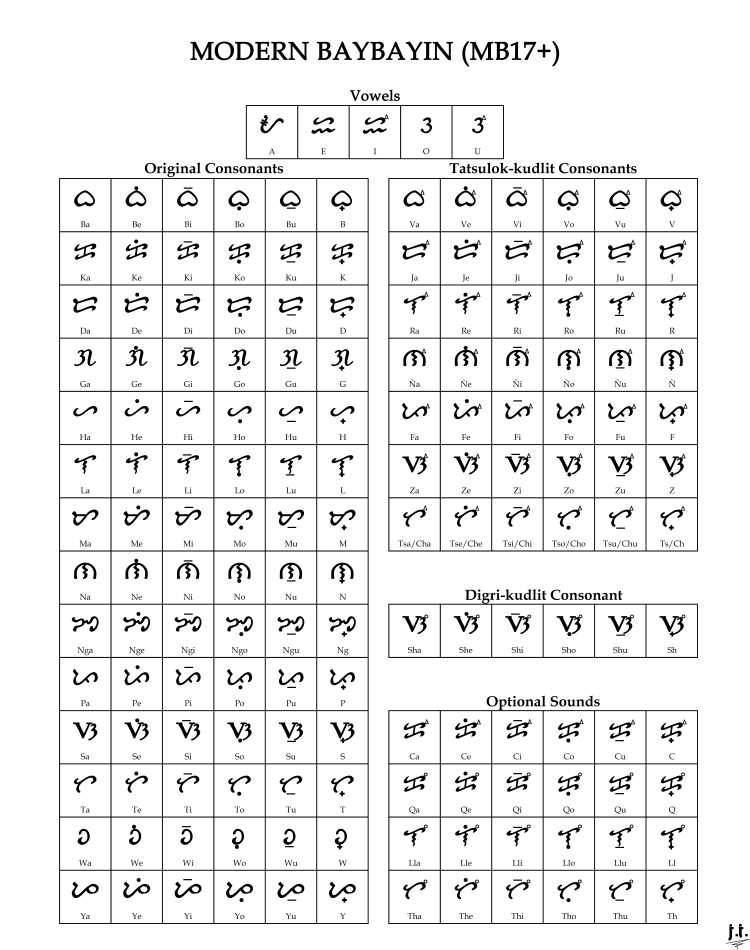
To Review
- Kung ano ang bigkas siyang baybay. (Spell it the way you say it.)
- It is up to you whether you would like to change your name to its Filipino equivalent or not.
- Do not treat the Baybayin characters like letters in the alphabet.
- Drop the final consonants in traditional writing.
- In traditional writing, separate the consonants and insert a vowel in between if the syllable starts with a consonant cluster.
- In the reformed way, use a virama for final consonants and consonant cluster.
- Do not use two vowel characters for diphthongs.
- Drop the silent letters and hyphen if there are any.
- Spell the full abbreviated name depending on the pronunciation.
- Lastly, just have fun!
I guess that is all we need to write our name in Baybayin. I hope I was able to help you write your name in Baybayin. If you have any question, please do not hesitate to ask below. ᜋᜇᜋᜒ ᜐᜎᜋ! / ᜋᜇᜋᜒᜅ᜔ ᜐᜎᜋᜆ᜔! God Bless =>
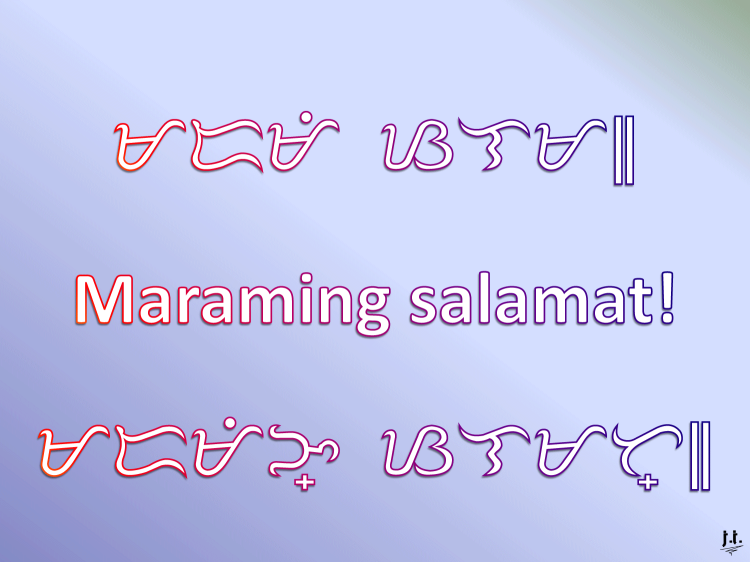

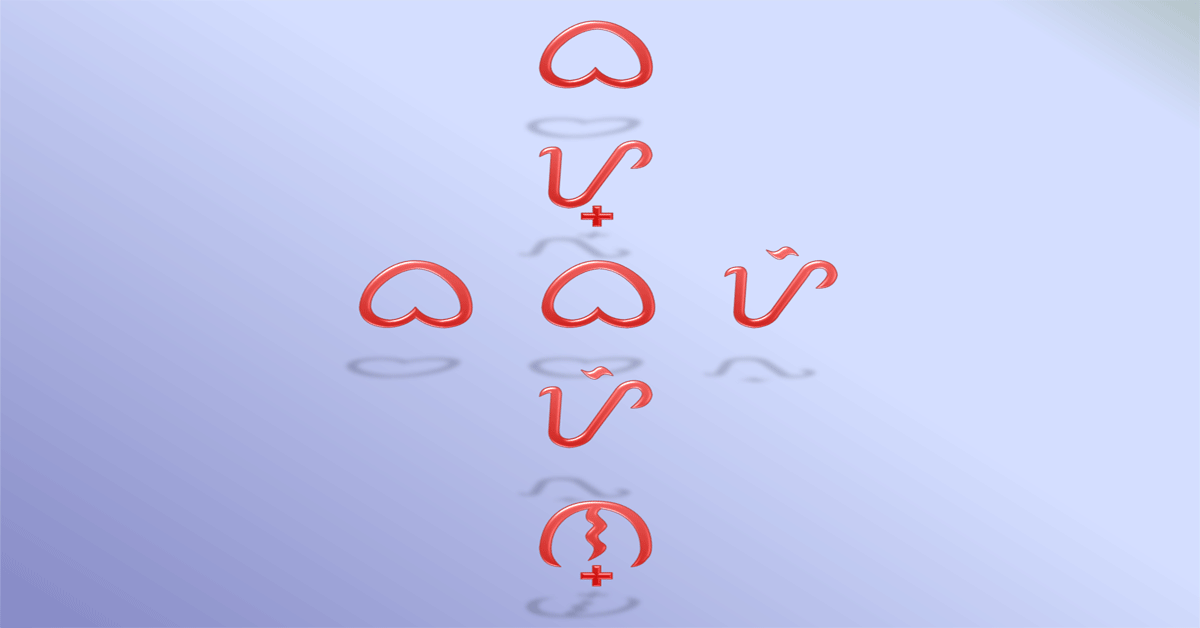
i want to translate my name in baybayin words. Cecil Dela Cruz
LikeLike
i want to translate my name in baybayin words. reina sabordo
LikeLike
How to translate my name in baybayin
Michael
Ria
LikeLike
Good day, How can i write the name LORIE in baybayin, Just to want to make it my tattoo. thank you
LikeLike
Hi! I would just like to ask for some help kasi in our school, our principal would like to have our school’s acronym to be translated into baybayin. That would be SREI. In baybayin ba would it be smthg like ES(a) AR(a) I AY(a)? Thank you for your help!
LikeLike
Hello Joachimrae, good day! Acronym and initialism are not advisable in Baybayin. However, for acronym (SREI is read as one word), then you can try: ᜁᜐ᜔ᜇᜒᜌ᜔ (Esrey). And yes, if initialism (each letter is read), you can try ᜁᜐ᜔ᜀᜇ᜔ᜁᜀᜌ᜔ (Es-ar-eh-ai)
There are also some suggestion in Nordenx’s blog post: https://nordenx.blogspot.com/2012/05/baybayin-acronyms-initials.html?m=1
Thank you and God Bless =>
LikeLike
can you translater the name of my wife? Jaycee Lyn 🙂
LikeLike
Can you translate my name, please?
LikeLike
Hi, can baybayin be written downwards?? like this one:
P
I
N
O
Y
LikeLike
Hello Enrique Legaspi, good day! Yes you can. 😊 Thank you and God Bless =>
LikeLike
I want to translate the name JIDEB in baybayin. Thank you.
LikeLike
How to write my name maria fatima
LikeLike
How to translate my name Francisco in baybayin
LikeLike
How to write my name Jet Petilo
LikeLike
Hello! Would you be able to help translate and write my family name? It would be a tribute to my late father. Thank you in advance! 🙂
LikeLike
My friend wants to get his name tattooed in baybayin his name is John Adam.
LikeLike
How to write floralyn
LikeLike
Hi – we have (what we believe to be) a traditional Filipino last name but wanted to see if you would be willing to confirm how we would spell it. Thanks in advance!
LikeLike
Pwede po ba paki sulat po sa baybayin ito “paghirapan mo” salamat po sa tutugon.
LikeLike
Hi can you help me out with writing me son’s name and my wife’s? His name is “Maui.” My wife’s name is “Karie.”
LikeLike
Hi how write Hiraya?
LikeLike
how can to translate the name saphire mercifull..
LikeLike
How to write gideon in baabayin
LikeLike
Pasuyo po pasulat neto in baybayin
Chastaine
Chris Ann
LikeLike
Hi, any recommendations for a good baybayin font that I can download. Will appreciate if anyone can share a link where to download. TIA
LikeLike
Hello Ryan, good day! You can check https://luffykudo.wordpress.com/baybayin/
Once there, just look for the “Baybayin Fonts” section. Thank you and God Bless =>
LikeLike
i want to know how to write Ryan and Desiree in baybayin..
LikeLike
Good day! Can I ask what is the Baybayin name of ROMELILY ?
LikeLike
Hello, Can someone please let me know what the names Gina and Camille would be translated to in Baybayin?
LikeLike
Hi can you please translate Vanessa in baybayin. thankyou
LikeLike
Could you help me out to write traditional old baybayin for my daughter’s name
Gabriella
LikeLike
Hi can you please translate reynaldo in baybayin. thankyou
LikeLike
How to write Dennis in baybayin/alibata
LikeLike
How to use properly the “x” and “+” below each baybayin? Thank you
LikeLike
Hello Tyroneforshort, good day! Just simply put them below a consonant character to cancel the default “a” sound.
Please note, however, that it will just cancel the default ending “a” sound but won’t turn the character into a single latin letter. So ᜊ᜔ is just the sound /b/ and not the letter B.
Thank you and God Bless =>
LikeLike
How to use “x” and “+” below each baybayin? Thanks
LikeLike
walang R
LikeLike
Hello Irene, good day! The character for Ra is the same sa Da. This is because Da and Ra are allophones in old Tagalog and Filipino. For example: dito/rito, doon/roon, and dinig/rinig among any other.
Visit https://luffykudo.wordpress.com/2020/08/10/how-to-read-and-write-baybayin/ for more info.
Thank you and God Bless =>
LikeLike
aberca pls translate
LikeLike
Hi this is just for confirmation, may I request for the babayin translation of the following:
Pepito
Helen
Thank you po.
LikeLike
How to Translate my name in Baybayin ipapatattoo ko siya, Thank you!
Ronald Quijano
LikeLike
How to translate my name in baybayin “adriyan” thank you 😊
LikeLike
Hi😁 this is just confirmation! May I request for the baybayin of my name Roberto. Hernandez. Bobier. Thank you
LikeLike
Melanie please translate
LikeLike
Do you ever respond to the comments?
LikeLike
Hello Cherry! Good day! Yes po, I do. 😊 Thank you and God Bless =>
LikeLike